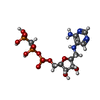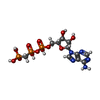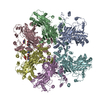+検索条件
-Structure paper
| タイトル | Structure and function of a hexameric cyanophycin synthetase 2. |
|---|---|
| ジャーナル・号・ページ | Protein Sci, Vol. 32, Issue 7, Page e4685, Year 2023 |
| 掲載日 | 2023年6月30日 |
 著者 著者 | Linda M D Markus / Itai Sharon / Kim Munro / Marcel Grogg / Donald Hilvert / Mike Strauss / T Martin Schmeing /   |
| PubMed 要旨 | Cyanophycin is a natural polymer composed of a poly-aspartate backbone with arginine attached to each of the aspartate sidechains. Produced by a wide range of bacteria, which mainly use it as a store ...Cyanophycin is a natural polymer composed of a poly-aspartate backbone with arginine attached to each of the aspartate sidechains. Produced by a wide range of bacteria, which mainly use it as a store of fixed nitrogen, it has many promising industrial applications. Cyanophycin can be synthesized from the amino acids Asp and Arg by the widespread cyanophycin synthetase 1 (CphA1), or from the dipeptide β-Asp-Arg by the cyanobacterial enzyme cyanophycin synthetase 2 (CphA2). CphA2 enzymes display a range of oligomeric states, from dimers to dodecamers. Recently, the crystal structure of a CphA2 dimer was solved but could not be obtained in complex with substrate. Here, we report cryo-EM structures of the hexameric CphA2 from Stanieria sp. at ~2.8 Å resolution, both with and without ATP analog and cyanophycin. The structures show a two-fold symmetrical, trimer-of-dimers hexameric architecture, and substrate-binding interactions that are similar to those of CphA1. Mutagenesis experiments demonstrate the importance of several conserved substrate-binding residues. We also find that a Q416A/R528G double mutation prevents hexamer formation and use this double mutant to show that hexamerization augments the rate of cyanophycin synthesis. Together, these results increase our mechanistic understanding of how an interesting green polymer is biosynthesized. |
 リンク リンク |  Protein Sci / Protein Sci /  PubMed:37222490 / PubMed:37222490 /  PubMed Central PubMed Central |
| 手法 | EM (単粒子) |
| 解像度 | 2.7 - 2.8 Å |
| 構造データ | EMDB-29533, PDB-8fxh: EMDB-29534, PDB-8fxi: |
| 化合物 |  ChemComp-YHZ:  ChemComp-MG:  ChemComp-ACP: |
| 由来 |
|
 キーワード キーワード | LIGASE / cyanophycin / CphA2 / ATP-grasp |
 ムービー
ムービー コントローラー
コントローラー 構造ビューア
構造ビューア 万見文献について
万見文献について







 Stanieria sp. (バクテリア)
Stanieria sp. (バクテリア)